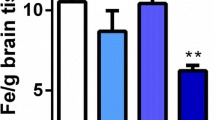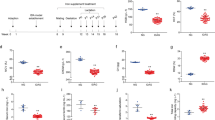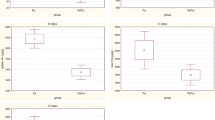Abstract
Undernutrition during pregnancy and/or lactation plays an important role on the overall health of offspring later in life. Using a rodent model, the present study was conducted to examine the effect of fetal and early postnatal iron deficiency on iron metabolism in adult animals. Rats were treated with three stages of low or normal iron diets from gestation until the end of the study. During the first stage (4 weeks prior to 3 weeks after pregnancy, total 7 weeks), two groups of adult females (dams) were fed with either a low-iron (7.4 mg iron/kg, group LD) or control-iron (274 mg/kg, group CD) diet. During the second stage (from 3 to 13 weeks of age, total 10 weeks), all pups from stage 1 (both the LD and CD groups) were placed on a control-iron diet for 10 weeks (groups LD–CD and CD–CD, respectively). During the third stage (from 13 to 29 weeks of age, total 16 weeks), both LD–CD and CD–CD groups from stage 2 were fed with a low-iron (named LD–CD–LD and CD–CD–LD groups, respectively). We found that the live birth rate of the offspring of the LD dams (84.7 %) was significantly lower than that of the CD dams (95.4 %). During stage 2, the mean body weight of the LD–CD male or LD–CD female rats exceeded the CD–CD male rats (p < 0.05). Compared with the CD–CD–LD rats, the LD–CD–LD rats had significantly increased total iron binding capacity, and higher levels of transferrin, serum erythropoietin (EPO), renal EPO mRNA, duodenal divalent metal transporter-1, and renal transferrin receptors. These findings indicate that rats with an early-life experience of iron deficiency (during pregnancy and the nursing period) can develop stronger iron absorption capabilities in adulthood.



Similar content being viewed by others
Abbreviations
- LD:
-
low-iron diet during pregnancy (first stage)
- CD:
-
control-iron diet during pregnancy (first stage)
- LD–CD:
-
first stage LD with control-iron diet from 3 to 13 weeks of age (second stage)
- CD–CD:
-
first stage CD with control-iron diet from 3 to 13 weeks of age (second stage)
- LD–CD–LD:
-
LD–CD rats with low-iron diet from 13 to 29 weeks of age (third stage)
- CD–CD–LD:
-
CD–CD rats with low-iron diet from 13–29 wks of age (3rd stage)
- SI:
-
serum iron
- SF:
-
serum ferritin
- sTfR:
-
serum transferrin receptors
- TIBC:
-
total iron binding capacity
- TF:
-
transferrin
- DMT-1:
-
divalent metal transporter 1
- EPO:
-
erythropoietin
- RET:
-
reticulocytes
References
Lucas A (1998) Programming by early nutrition: an experimental approach. J Nutr 128(2 Suppl):401–406
Langley-Evans SC, Gardner DS, Welham SJ (1998) Intrauterine programming of cardiovascular disease by maternal nutritional status. Nutrition 14:39–47
Gambling L, Dunford S, Wallace DI, Zuur G, Solanky N, Srai SK, McArdle HJ (2003) Iron deficiency during pregnancy affect postnatal blood pressure in the rat. J Physiolo 552:603–610
Leblanc CP, Surette ME, Fiset S, Turgeon O'Brien H, Rioux FM (2009) Maternal iron deficiency and its effect on essential fatty acid and eicosanoid metabolism and spatial memory in the guineapig offspring. Prostaglandins, Leukot Essent Fat Acids 81:1–8
Lisle SJ, Lewis RW, Petry CJ, Ozanne SE, Hales CN, Forhead AJ (2003) Effect of maternal iron restriction during pregnancy on renal morphology in the adult rat offspring. Br J Nutr 90:33–39
Lawlor DA, Smith GD (2005) Early life determinants of adult blood pressure. Curr Opin Nephrol Hypertens 14:259–264
Andersen HS, Gambling L, Holtrop G, McArdle HJ (2007) Effect of dietary copper deficiency on iron metabolism in the pregnant rat. Br J Nutr 97:239–46
Tarry-Adkins JL, Ozanne SE (2011) Mechanisms of early life programming: current knowledge and future directions. Am J Clin Nutr 94:1765–1771
Barker DJ, Martyn CN (1992) The materal and fetal origins of cardiovascular diseases. Epidemiol Community Health 46:8–11
Barker DJ, Gluckman PD, Godfrey KM, Harding JE, Owens JA, Robinson JS (1993) Fetal nutrition and cardiovascular disease in adult life. Lancet 341:938–941
Andersen HS, Gambling L, Holtrop G, McArdle HJ (2006) Maternal iron deficiency identifies critical windows for growth and cardiovascular development in the rat post implantation embryo. J Nutr 136:1171–1177
Li H, Stein AD, Barnhart HX, Ramakrishnan U, Martorell R (2003) Association between prenatal and postnatal growth and adult body size and composition. Am J Clin Nutr 77:1498–1505
Wu G, Bazer FW, Cudd TA, Meininger CJ, Spencer TE (2004) Maternal nutrition and fetal development. J Nutr 134:2169–2172
Paiva Ade A, Rondó PH, Pagliusi RA, Latorre Mdo R, Cardoso MA, Gondim SS (2007) Relationship between the iron status of pregnant women and their newborns. Rev Saude Publica 41:321–327
Fowden AL, Giussani DA, Forhead AJ (2006) Intrauterine programming of physiological systems: causes and consequences. Physiology (Bethesda) 21:29–37
World Health Origanization(2002) The World Health Report 2002. Reducing risks, promoting health life. Geneva, Switzerland: World Health Origanization
Ponka P (2000) Iron metabolism: physiology and pathophysiology. J Trace Elem Exp Med 13:73–83
The Chinese Children; Pregnant Women & Premenopausal Women Iron Deficiency Epidemiological Survey Group (2004) Prevalence of iron deficiency in pregnant and premenopausal women in China: a nationwide epidemiological survey. Chin J Hematol 25:653–657
Scholl TO (2005) Iron status during pregnancy: setting the stage for mother and infant. Am J Clin Nutr 81:1218–1222
Gambling L, Andersen HS, Czopek A, Wojciak R, Krejpcio Z, Mcardle HJ (2004) Effect of timing of iron supplementation on maternal and neonatal growth and iron status of iron-deficient pregnant rats. J Physiol 561:195–203
O'Brien KO, Zavaleta N, Abrams SA, Caulfield LE (2003) Maternal iron status influences iron transfer to the fetus during the third trimester of pregnancy. Am J Clin Nutr 77:924–930
Gambling L, Lang C, McArdle HJ (2011) Fetal regulation of iron transport during pregnancy. Am J Clin Nutr 94:1903–1907
Vickers MH, Breier BH, Cutfield WS, Hofman PL, Gluckman PD (2000) Fetal origins of hyperphagia, obesity and hypertension and its postnatal amplification by hypercaloric nutrition. Am J Physiol Endocrinol Metab 279:83–87
Christian P, Stewart CP (2010) Maternal micronutrient deficiency, fetal development, and the risk of chronic disease. J Nutr 140:437–445
Lewis RM, Petry CJ, Ozanne SE, Hales CN (2001) Effect of maternal iron restriction in the rat on blood pressure, glucose tolerance, and serum lipids in the 3-month-old offspring. Metabolism 50:562–567
Swali A, McMullen S, Langley-Evans SC (2010) Prenatal protein restriction leads to a disparity between aortic and peripheral blood pressure in Wistar male offspring. J Physiol 588:3809–3818
Gambling L, Danzeisen R, Gair S, Lea RG, Charania Z, Solanky N, Joory KD, Srai SK, McArdle HJ (2001) Effect of iron deficiency on placental transfer of iron and expression of iron transport proteins in vivo and in vitro. Biochem J 356:883–889
Theurl I, Ludwiczek S, Eller P, Seifert M, Artner E, Brunner P, Weiss G (2005) Pathways for the regulation of body iron homeostasis in response to experimental iron overload. J Hepatol 43:711–719
Allen LH (2000) Anemia and iron deficiency and iron deficiency: effects on pregnancy outcome. Am J Clin Nutr 71:1280–1284
Hamalainen H, Hakkarainen S (2003) Anaemia in the first but not in the second or third trimester is a risk factor for low birth weight. Clin Nutr 22:271–275
Scholl TO, Hediger ML (1994) Anaemia and iron-deficiency anaemia:complication of data on pregnancy outcome. Am J Clin Nutr 59:492–500
Rao R, Georgieff MK (2002) Perinatal aspects of iron metabolism. Acta Paediatr 438:124–129
Cogswell ME, Parvanta I, Ickes L, Yip R, Brittenham GM (2003) Iron supplement during pregnancy, anemia, and birth weight: a randomized controlled trial. Am J Clin Nutr 78:773–781
Unger EL, Paul T, Murray-Kolb LE, Felt B, Jones BC, Beard JL (2007) Early iron deficiency alters sensorimotor development and brain monoamines in rats. J Nutr 137:118–124
Brion MJ, Leary SD, Smith GD, McArdle HJ, Ness AR (2008) Maternal anemia, iron intake in pregnancy, and offspring blood pressure in the Avon longitudinal study of parents and children. Am J Clin Nutr 88:1126–1133
Zhang J, Lewis RM, Wang C, Hales N, Byrne CD (2005) Maternal dietary iron restriction modulates hepatic lipid metabolism in the fetuses. Am J Physiol Regul Integr Comp Physiol 288:R104–R111
Wu LL, Zhang L, Shao J, Qin YF, Yang RW, Zhao ZY (2008) Effect of perinatal iron deficiency on myelination and associated behaviors in rat pups. Behav Brain Res 188:263–270
Ward KL, Tkac I, Jing Y, Felt B, Beard J, Connor J, Schallert T, Georgieff MK, Rao R (2007) Gestational and lactational iron deficiency alters the developing striatal metabolome and associated behaviors in young rats. J Nutr 137:1043–1049
Liao QK (1992) Effect of placental transferrin receptors iron nutritional state of normal full time gravidas and their newborns. Zhonghua yixue za zhi 72:619–621
Barker DJ (1995) Fetal origins of cornary heart disease. BMJ 15:171–174
Acknowledgments
We are very grateful to Prof. Zuzhao Zhou (Department of Biochemistry, Shihezi University School of Medicine) who offered his support and guidance during this study.
Funding Sources
This work is supported by the National Natural Science Foundation of China (NSFC-30600500).
Author information
Authors and Affiliations
Corresponding author
Rights and permissions
About this article
Cite this article
Fu, J., Yang, A., Ma, Y. et al. The Effect of Fetal and Early Postnatal Iron Deficiency on Iron Metabolism in Adult Rats. Biol Trace Elem Res 149, 412–418 (2012). https://doi.org/10.1007/s12011-012-9447-0
Received:
Accepted:
Published:
Issue Date:
DOI: https://doi.org/10.1007/s12011-012-9447-0




